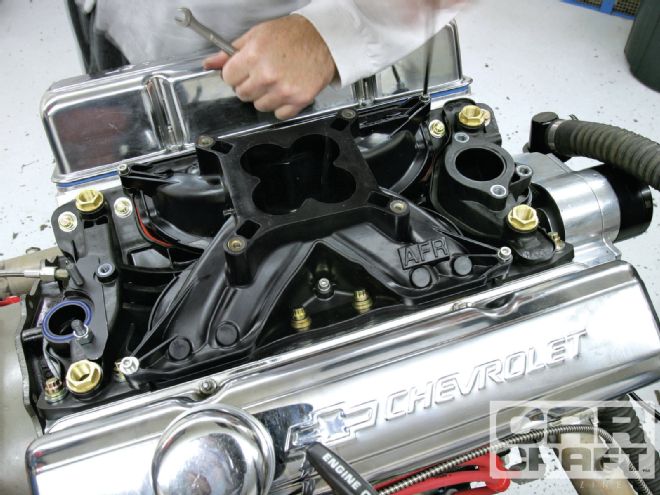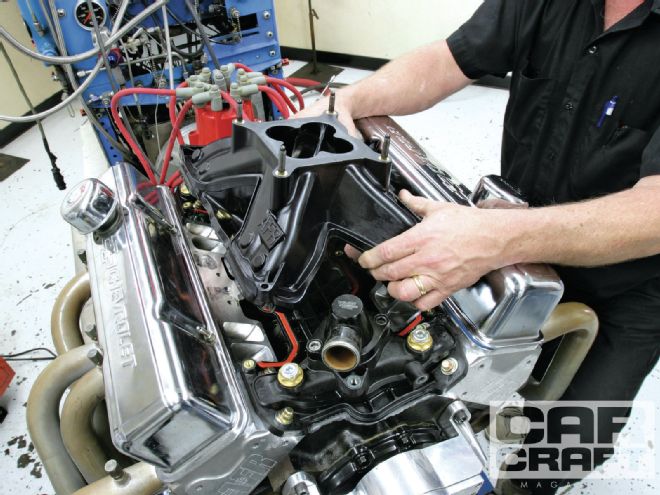
If we were to do a car-guy movie remake of the "bring out your dead" scene from Monty Python and the Holy Grail, there would be plenty of enthusiasts insisting that the small-block Chevy is nowhere near death. Evidence that the venerable Mouse motor still has a strong pulse is when a company like Air Flow Research debuts a brand-new composite intake manifold for street and strip. Not only is this manifold made of 21st century composite material, but its modular two-piece design allows quick and easy changes among three different upper "spider" configurations. The low-rise, single-plane manifold is called the Titan X Street (TXS), while its taller, single-plane cousin goes by Titan X Race (TXR). We didn't get a chance to test the Titan dual-plane (DPR) version, but it nestles into the same base as its single-plane siblings. The beauty is that you could literally change intake designs in your driveway in a matter of minutes because the upper spider requires only a handful of fasteners and you are not bothered by draining coolant or removing the distributor.
Rather than settling for a lame forum story of appearance platitudes and part numbers, we persuaded AFR to let us test this composite intake manifold on the back of a Car Craft mule motor. Resting comfortably on the shop floor was a well-seasoned GM Performance Parts HT 383 short-block that had recently escaped from our Orange Peel '66 Chevelle's engine compartment and was therefore overdue for a flogging. Then Tony Mamo from AFR suggested testing a set of the company's brand-new Version 2 195cc Competition ported heads in conjunction with the Titan composite intake manifolds. By now you've probably already cut to the end of this story to uncover the dyno results. What's not covered in the composite intake manifold comparisons however, is that we bumped the ignition lead 2 more degrees for one last heroic pull and bumped the power another 2 hp to an amazing 561 hp at 6,200 rpm with the TXR lid. Certainly the Comp Cams 288 Xtreme Energy hydraulic roller cam, Holley HP 950 carburetor, and open 17⁄8-inch headers contributed to the overall power. This engine also made well over 425 lb-ft of torque even down at 3,100 rpm, so it's no slouch down low. With such impressive power with our first effort, we're already wondering what a little extra tuning might deliver. Could we push this beast to 575 or more? Clearly our veteran Mouse is still a long way from the graveyard.
The AFR Titan Composite Intake Manifold
AFR's new Titan composite intake manifold series of intakes employs the current composite-materials technology and has retrofitted it back to the classic small-block Chevy. While more expensive to build than a cast-aluminum manifold, this manifold's composite material offers multiple advantages. Right off, the composite is lighter, as much as 10 pounds or more depending on the size of the manifold you are replacing. Moreover, the composite promises cooler inlet air temperatures in street use with its insulator qualities, so the carburetor should remain much cooler, which will help on hot days with vapor lock issues. But the really intriguing part is the two-piece design that allows you to swap the upper manifold portion in a matter of minutes without having to drain water or remove the distributor. The entire composite intake manifold is sealed with rubber inserts that are dedicated for this manifold and are completely reusable. AFR supplies all the seals and intake fasteners with the manifold, making it truly a bolt-on affair.
The Heads
To make this test even spicier, we included a new set of AFR 195cc Competition ported heads that sport an upgraded CNC program that should be available from AFR by the time you read this. Mamo claims that with some minor tweaks, he's been able to improve the flow numbers by a couple of percent, yet the price and the part numbers for the Competition ported heads remain the same. So if you've been putting off buying a set of heads, then now's the time. Mamo says the heads will flow in excess of 300 cfm at more than 0.600-inch lift, which is on the ragged edge of what might be considered streetable, but our test with 0.555-inch intake lift was enough to push our 383 to 560 hp, so the potential is real.
The Engine
In a previous life, our test engine was a GM Performance Parts HT 383 with a mild Comp hydraulic roller cam, a set of TFS 210cc heads, an Edelbrock Performer RPM Air-Gap dual-plane, and a 750-cfm Holley that made a respectable 490 hp and more than 500 lb-ft of torque. We began our tune-up with a bigger Comp Xtreme Energy 288 hydraulic roller cam. For heads, it only seemed fitting to use a set of AFRs, and Mamo offered to let us test a brand-new set of revised AFR Competition CNC-ported 195 heads that should be available by the time you read this. However, since our engine is still running hypereutectic pistons and stock rods, we elected to keep the peak power below 6,500 rpm.
Test Day
To get a sense of how well both Titan intake manifolds worked, we needed a solid baseline for comparison. When it comes to small-block Chevy single-plane intake manifolds, the accepted benchmark has to be the Edelbrock Victor Jr. This manifold has been around for nearly two decades and continues to be a small-block performance standard. From a carburetor height standpoint, the Titan TXS is closest in terms of runner length while the TXR is more than an inch taller, benefiting from longer runners that improve midrange torque. The veteran Victor Jr. made excellent power, cranking 504 lb-ft for torque and an outstanding 531 hp at the peak. We then swapped to the Titan TXS and the overall power picked up across the board. Perhaps the most impressive gain was the 19hp peak bump from 531 to 550 hp, but the average torque also improved 9 lb-ft. So it wasn't too surprising that the taller Titan TXR intake performed even better. Right from the start of the test at 3,000 rpm, the taller Titan produced double-digit torque increases over both the shorter Titan TXS and the Victor Jr. The chart's "Difference" column shows the total TXR improvement over the baseline. Average torque for the TXR also increased, showing a 9-lb-ft average gain over its shorter TXS cousin and an impressive 18 lb-ft compared with the Victor Jr.
 Swapping to the taller Titan TXR top took less than five minutes to complete. The taller top was worth a “you’ll feel that in the seat of your pants” of as much as 28 hp over the Victor Jr and also 8 to 11 lb-ft of torque over the TXS lid. Note the cloverleaf-style carb pad that tends to direct air and fuel and minimize turbulence in the plenum.
Swapping to the taller Titan TXR top took less than five minutes to complete. The taller top was worth a “you’ll feel that in the seat of your pants” of as much as 28 hp over the Victor Jr and also 8 to 11 lb-ft of torque over the TXS lid. Note the cloverleaf-style carb pad that tends to direct air and fuel and minimize turbulence in the plenum.
We also tested the manifolds at a higher engine coolant temperature to see if we could measure a composite power increase over aluminum, but the percentage of gain of the composite versus aluminum really didn't reveal very much. However, under normal street driving, we think it's possible that the composite material will maintain a cooler intake air temperature.
Cam Specs CamshaftAdvertised DurationDuration at 0.050Lift (Inches)Lobe-separation Comp XR288HR, intake2882360.520*110 Exhaust2942420.540* *Note: These are the lift specs for a 1.5:1 rocker ratio. With Comp’s Ultra Pro Magnum steel 1.6:1 rockers, the actual lift jumped to 0.555 inch for the intake and 0.576 inch on the exhaust. Power Numbers RPMVictor Jr.Titan TXSTitan TXRDifference TQHPTQHPTQHPTQHP 3,000409234415237426243179 3,200415253417254430262159 3,400432280432279445288138 3,6004473064503084603161310 3,8004633354683394793471612 4,0004743614823674913741713 4,2004813854913924993991814 4,4004884094984175064241815 4,6004944325024405114481716 4,8005004575084645184731816 5,0005044805124875204951615 5,2005024975105055205151818 5,4004965105065215145281818 5,6004855174985325045381921 5,8004735234895404955462223 6,0004635294785474865562327 6,2004505314655504745592428 6,4004355304505494575572227 Peak Power5045315125505205591628 Avg. Power467.6424.6476.6433.7485.6441.51816.9 Parts List Description PN Source Price AFR Titan DPR, dual-plane 4804 Summit Racing $598.95 AFR Titan TXS, single-plane 4802 Summit Racing 598.95 AFR Titan TXR, tall single-plane 4801 Summit Racing 581.95 Edelbrock Victor Jr. intake 2975 Summit Racing 215.95 Comp hydraulic roller Xtreme E 12-433-8 Summit Racing 288.95 Comp hydraulic roller lifters 850-16 Summit Racing 209.95 Comp Ultra Pro 1.6:1 rockers 1605-16 Summit Racing 324.95 Comp billet roller timing set 7136 Summit Racing 92.95 Holley HP 850 carb 0-80496-1 Summit Racing 739.95 Quaker State, Q Horsepower 5W-20 Advance Auto 6.29 ea. Bosch FR 6 DC+ spark plugs FR6 DC(7524) Local auto parts 16 GMPP 383 short-block 12499106 Scoggin-Dickey 3,599.95 TXS top 4651 AFR 393 TXR top 4650 AFR 393 DPR top 4653 AFR 393